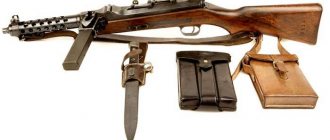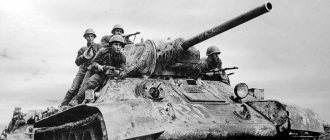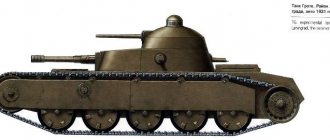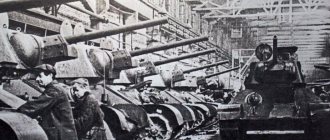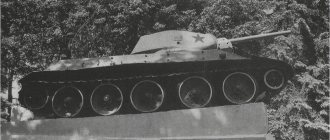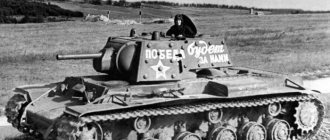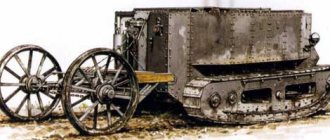"T-24" redirects here. For other uses, see T24 (disambiguation).
| This article requires additional links for verification . |
Medium tank
| Medium tank T-24 | |
| Type | Medium tank |
| Place of origin | Soviet Union |
| Service history | |
| Used | Soviet Union |
| Production history | |
| Designer | Ivan Nikolaevich Aleksenko, KB T2K |
| Developed | 1930 |
| Manufacturer | KhPZ |
| Produced | 1931 |
| No built | 25 |
| Options | A prototype of the T-12 tank, artillery tractors Komintern and Voroshilovets |
| Characteristics | |
| Weight | 18.5 tons |
| Length | 6.50 m (21 ft 4 in) |
| Width | 3.00 m (9 ft 10 in) |
| Height | 2.81 m (9 ft 3 in) |
| Crew | 5 |
| Armor | 8–20 mm |
| Main weapons | 45 mm gun Model 32 |
| Secondary weapons | 3 × DT machine gun |
| Engine | 250 hp (190 kW) |
| Power/weight | 13.5 hp / ton |
| Suspense | vertical spring |
| Operating range | 140 km |
| Maximum speed | 25 km/h (16 mph) |
T-24
was a Soviet medium tank built in 1931. Only twenty-four were built, and none saw combat. It was the first tank produced at the KhPZ plant in Kharkov, which later went on to produce the highly successful Soviet tanks of the BT, T-34 and T-54 series. The T-24 suspension was successfully used in the first special-purpose artillery tractors in the Soviet Union.
The main armament of the T-24 is a 45 mm cannon. It had a 7.62 mm DT machine gun with a ball mount in the hull, another in the turret and a third in the auxiliary turret on top of the main turret. The tank was well armored for its time, but there were problems with the engine and transmission.
Production history [edit]
A tank design bureau was established at the Kharkov Locomotive Plant (KhPZ) in Kharkov, Soviet Ukraine in 1928. The plant's first tank project was the T-12 (or T-1-12). It was a larger version of the T-18 with a more powerful engine (the T-18 was based on the Renault FT). The idea of the T-24 tank was so great that in August 1930, the Revolutionary Military Council (RVS) ordered a staggering 1,600 T-24 tanks, compared to the 900 tanks produced worldwide over the years. [1]
The T-24 was put into service as an attempt to restore the equipment that was placed in the T-12 tank. The T-24's demise was due to factors that were overlooked to compensate for the T-12's oversight, which resulted in the T-24 suffering from what were considered major deficiencies. This included mechanical errors in the transmission and suspension. After the construction of twenty-five T-24 tanks, the entire project was abandoned. One prototype was built and production of thirty tanks was authorized in 1930, but vehicle performance was so disappointing that it was decided to undertake further development work. A total of twenty-five tanks were built. [2] Over time, the remaining tanks were used as tank training units for the Red Army. [3]
The project was renamed the T-24, work was completed to correct problems with the transmission and fuel system, and a larger turret was designed. Initial tests were carried out and the performance was found to be satisfactory, although the prototype's engine caught fire and the turret had to be transferred to the T-12 prototype for further testing. Only twenty-four tanks were built in 1931. T-24s were initially armed only with machine guns until 45 mm guns were installed the following year.
The T-24 was considered unreliable and was used only for training and parades. Although the T-24 tank was unsuccessful, it gave KhPZ initial experience in tank design and production, which was used with great success in mastering the production of the American Christie tank as a series of BT tanks, starting in 1931.
The T-24 was ultimately canceled midway through production due to its position in the line of Soviet tanks that already existed at the time. The T-24 was intended to fill a gap in the existing lineup of light and heavy tanks by introducing medium tank mechanics. During the T-24 design process, the Soviets focused on many sources to solve their problem, including the T-19, T-21, and T-23 tanks. [4] However, during testing, the T-24 competed with the more widely known Grotte-1 tank, also known as the TG-1 and eventually called the T-22 in the USSR. [5]
Comintern artillery tractor
Heavy artillery tractor Voroshilovets
Artillery tractors[edit]
Artillery tractor
The KhPZ
Komintern
was based on the suspension of the T-12 tank (50 units from 1930) and then the T-24 (2,000 units from 1935 to 1941) with a 131 hp diesel engine.
Unlike its predecessor tanks, the tractor turned out to be more successful and was put into mass production. The Comintern
inherited several T-24s with shortcomings (for example, slow mobility), but some of them [
clarify
] were fixed by the designers, others were not as significant for a tractor as for a tank.
The Comintern
was used to tow medium artillery such as 152 mm howitzer guns.
Heavy artillery tractor
The
Voroshilovets
was also based on the T-24 suspension with the same but detuned V-2 model diesel engine as the BT-7M and T-34 tanks. About 230 were built at KhPZ from 1939, and after the German invasion in 1941, production was moved to the Stalingrad Tractor Plant until August 1942.
T-24 - a tank ahead of its time
The history of this tank, which can easily be considered the grandfather of the T-34, for me personally began a very long time ago. While still a boy, in the magazine “Science and Life” in small pictures at the bottom of the page, made in black and white graphics, I saw two tanks that amazed me - the T-24 and TG. Then I came across the same “selection” in the magazine “Young Technician”, but there was nothing about these tanks in either magazine. Then the T-24 drawing with a brief text was found in the book “Knights of Armor” by N. Ermolovich. And in 1980 I made my first tank - a model of the first Soviet tank “Freedom Fighter Comrade. Lenin”, which won the toy competition of the USSR Ministry of Light Industry. This was followed by the following series: T-27, T-26, BT-5, T-35, IS-2, which also won the 1982 competition. But... I wanted to make a model of a previously unknown tank for the competition, which few people knew about and which, nevertheless, would play a certain role in the history of the development of domestic armored vehicles. And I turned everywhere in search of his drawings, even to the famous Leninka Library. Lenin in Moscow, where, by the way, I found the drawings of the T-27 tankette... in the list of chipboards ("Soviet secret"), and they never gave them to me... in 1988!
T-24 from the magazine “Model Designer No. 9, 1989”
But then, when I wrote to NAMI that, they say, I am so-and-so and I need drawings of little-known tanks of the USSR, from where (this was already 1989) came a heavy envelope with... blueprints T-24, T- 37 and T-27 with a cannon! True, the last two vehicles were given in fragments, the drawings were collected “from pine to pine forest”, but on the T-24 the blue was simply in perfect condition, with all the signatures, performance characteristics and dimensions. And it was simply huge, on a scale of 1:10, almost filling half the room! That is, it was all so unnecessary that they were happy to sell it all to someone, and not just burn it in the backyard.
That’s how I became the owner of this rare blue and... since I was already a member of the British association of modellers MAFVA, I decided to write an article about this tank for their magazine and wrote it. With great difficulty I found a person who, based on this blueprint, made me drawings on a scale of 1:35 and a small amount of material (and the Tanquette magazine itself was small), which went there and was immediately published. The second material, already of a larger size, went to the “Modelist-Constructor” magazine. But they didn’t believe me there! “The drawings are considered lost! Where did you get them from?” I’m writing from the blue, they say, and the blue is from US. “Send it to us for examination!” I sent it, and in the end it got screwed up there in the editorial office, but a large article about the T-12/T-24 tanks appeared in “Model Designer” No. 9 for 1989, along with a very beautiful color insert. The article, authored by Romadin, Baryatinsky and Shpakovsky, began with the words that, undoubtedly, the proposed material for all those interested in armored vehicles will be a real sensation, since no one had previously written about the T-12/T-24 tanks, and in such detail. And although my colleagues wrote a lot in it, especially about the T-12, I was very glad that if my blueprint were not there, this article would not exist! And so, some time after 1991, even a prefabricated model of the T-24 was released to the delight of BTT modellers and collectors.
And since there is hardly any point in repeating and writing about what has already been written, it seems to me that something else will be more interesting, namely, to consider this tank through the prism of our current knowledge, to look at the possibilities, missed chances and prospects of this vehicle.
T-24 in “war paint”. Impressive, isn't it?!
So, the tank appeared in the USSR at a turning point, namely in 1930. This year was a turning point in all respects, primarily because... another global crisis of capitalism began in the West. And the crisis is the discontent of the working people, a revolutionary situation and a world revolution, which all the newspapers wrote about then, but which for some reason did not happen and did not happen. But if it had started “there” and “their” proletariat had asked us, surely the carts wouldn’t have rushed to the West? Of course they would have rushed, but then there would have been a problem with the tanks: they simply weren’t there. That is, of course, there were MS-1s, and a lot of them, but this was not at all what was required. They would not have reached the Atlantic Ocean. As A. Gaidar wrote in his story “The Commandant of the Snow Fortress” (though not about tanks, but about a tractor, but in general it is very similar) - “the gasoline tank is small and the drive gears are large.”
T-24 during sea trials without weapons.
But the most interesting thing is not that the tank “arrived” in time for the crisis of 1929, but that they began to develop it in the USSR in 1927, when there was not even a hint of any crises in the West, and complete “prosperity” reigned there. And yet, we began work on a technically complex “maneuverable tank” with multi-tiered weapons. Again, it is interesting that this design had both many advantages and many disadvantages. The advantage was the ability to fire in several directions simultaneously, which was later proven on the American M3 Lee tanks. But the disadvantage is the same as that of the “Lee”: the tank’s high height, and also difficulties with rotating the upper and lower turrets - turning the lower one disrupted the aiming of the upper one. The tank was to be produced by the Kharkov Locomotive Plant.
First they made the T-12 (and it’s interesting that it was supposed to have twin 6.5-mm Fedorov machine guns chambered for the Japanese cartridge). The tank was tested, then it was modernized, and this is how the T-24 tank turned out. Now let's see what foreign tank from 1927, 1928, 1929 can it be compared with? There are no such! Its peer, the Vickers Medium, had a front engine, an exorbitant height, one 47 mm cannon and one machine gun in the turret, two on the sides, 16-8 mm armor and a speed of 24 km/h.
Medium tank T-24: 1 - guide wheel, 2 - track tension mechanism. 3 — suspension bogie, 4 — drive wheel, 5 — muffler, 6 — fender, 7 — main turret hatch, 8 — small turret hatch, 9 — armored flaps of fuel and oil tank necks, 10 — engine-transmission compartment covers, 11 — three-leaf driver's hatch, 12 — towing eye.
The T-24, which became the first Soviet medium tank to go into mass production, had a 45 mm cannon and two DT machine guns in the turret, and two more machine guns in the upper turret and in the front hull. The thickness of the main armor was 20 mm. The speed is only two kilometers less than that of the “Englishman”.
Prefabricated polystyrene model of the T-24 tank in 1:35 scale from Hobby Boss. Our cars are respected abroad, huh? And even these!
The crew of the T-24 was thought out very rationally: a commander, a gunner, a driver and two machine gunners. The armor was also rational - it had an inclined arrangement of armor plates on the front of the hull. The undercarriage rollers had rubber tires, and the elastic suspension elements were vertical spiral springs protected by armor casings. The tank had a traditional removable “tail”, but in this case it did not spoil it. The 8-cylinder M-6 aircraft engine had a power of 300 hp, which was quite enough for an 18.5-ton tank, since its specific power was 16 hp. per ton of weight. But during the first tests in the summer of 1930, the tank was let down by a poorly designed cooling system, which even caused the engine to catch fire.
The gun's ammunition included 89 rounds, including armor-piercing, fragmentation shells and even... buckshot. But although the tank itself was ready by 1930, the T-24 guns were received only in 1932, and before that they were used only with machine gun armament.
Tank during sea trials.
The first 15 serial T-24s were made in the second half of 1930 at the Kharkov Locomotive Plant, and the armored tank hulls for them were produced at the Izhora Plant. Then they made 10 more T-24s, after which the model of this tank was discontinued. These tanks never took part in battles, but were used exclusively as training tanks. Also a very interesting technical solution was the unification of the chassis of this tank with the Komintern artillery tractor, which made it possible to significantly speed up the motorization of the Red Army and facilitate the development of the vehicle among the troops. That is, in all respects it was a tank ahead of its time in the years 1927-29, corresponding to its time until the mid-30s and outdated immediately after the outbreak of the Spanish Civil War. However, all this time there was no equal to him either in England or in France, much less in Germany and Poland. That is, the level of design talent among its creators was not just satisfactory, no, it was very high! What was bad then? But the technological basis of production at that time was bad, or rather bad! That is, the embodiment of ideas in metal. Well, how do you understand this when the tank is already in metal, but the gun for it is still being developed? Again, when the Americans needed an M3 tank, they made it from start to finish in just nine months and immediately put it into production. And here, with a high level of engineering development of the design, there were dozens of technological “punctures”: the engine burned, the tracks flew off, the clutches worked poorly. The equipment used to produce the tank was useless. That is, many parts were adjusted to size using a file. Naturally, the cost of such a “handmade” tank was very high. Unfortunately, 80 years have passed, but the low level of technological support has not been completely eliminated even today. Well, in the past it was almost the norm. Let us recall the termination of acceptance of the T-34 due to technological defects and even cracks in the armor, the falling wings of the Yaks, the huge number of defects of the first radars, remote fuses, as clearly evidenced by the materials of the party archives. Come up with anything! To make it in metal with the same quality (do not buy everything that is done at the end of the month!) is an almost impossible task - this is the scourge, and a long-term one, of Soviet industry.
Assembled and painted model of the T-24.
Well, if we hypothetically look at the T-24, then we will have a tank in front of us, the development of which - a more powerful engine, thicker armor, a more powerful gun, could determine the shape of Soviet tank building for decades through a consistent transition from one modification to another , more perfect! And, perhaps, the T-34 would then have appeared on its basis much earlier. That is, this is a tank... yes, it was ahead of its time, but due to the technological backwardness of production at that time, it never had its say in battle and remained, in fact, an experimental machine.
T-24 tank, used as an artillery target.
Design process[edit]
In search of a heavily armored tank in the "medium tank" category, the Soviets created a committee called the "Tank Design Bureau" at the Kharkov Locomotive Plant. [4] The committee began with designs for a large version of the T-18, this was the original T-12. The T-12 will have a more powerful 200 horsepower engine and larger guns. [2] The committee initially created 30 T-12s with budgetary allocations in 1930. The T-12 prototypes were characterized as an imperfect design, and it was decided that a new design would be developed entirely.
Eventually, the project was renamed the T-24, which underwent many changes, including a more complex design. The initial changes were to fix problems with the transmission and fuel system, which made it possible to get a larger turret. [4] The hull was widened to provide more space, and the turrets were now rounded rather than octagonal. The T-24 also provided greater armor in certain areas.
Between 1930 and 1931, the improvements the T-24 made to the T-12 were promising, with 300 more tanks than originally planned. However, during testing of the first 25 produced, problems arose again, calling into question the reliability of the T-24. The T-24 was discontinued not only due to shortcomings, but also due to the complexity of manufacturing. [4]
History of creation
After the Civil and First World Wars, the USSR army had a large number of captured tanks. Because of this, Soviet tanks were not produced for a long time. When there were not enough guns and equipment, Soviet designers were given an order to create projects for “small” and “maneuverable” tanks. “Small” eventually became the widely known MS-1, and on its basis a “maneuverable” vehicle was created - the experimental T-12 tank.
When the prototype T-12 was built, it was found not to meet the new requirements. Then in 1930 the T-24 project, a modernization of the T-12, was developed. The T-24's range was increased, the armor thickness was reduced, and the turret design was changed. The creators also completely redesigned the combat body, which made it possible to install a radio station in the tank.
Between 1930 and 1931, the factories produced 9 chassis, 17 turrets and 25 hulls. In the end, only nine tanks were produced. Due to economic conditions, it was not possible to establish mass production of tanks, and the designers were unable to improve the performance of the units and components of the vehicle.
In June 1931, the order was given to begin designing the wheeled-tracked light tank BT, and all work on the T-24 was curtailed. The tanks were delivered to the Red Army, but they were quickly made into training tanks, and then completely removed from service.
Specifications [edit]
Size[edit]
The T-24 had a chassis 5.68 meters long, 2.8 meters wide and 3 meters high. Thus, the crew was about five people. Compared to American tanks of World War II, the T-24 has almost the same dimensions as the M4 Sherman tank, but is larger than the infamous American M18 Hellcat.
Engine[edit]
The T-24 tank had a single 8-cylinder M-6 engine. The engine ran on gasoline and developed from 250 to 300 horsepower. This engine configuration allowed the tank to reach a top speed of 25 kilometers per hour (16 mph). The T-24 tank had a fuel tank large enough to travel 120 kilometers (75 miles). [2]
Weapons [edit]
The T-24 tank has one 45 mm Model 32 cannon as the main turret. The T-24 is also equipped with 3 x 7.62mm DT machine guns located around a coaxial mount in the main turret, in the forward left nose (forward facing) allowing for flexibility in targeting, and finally a separately controlled turret above the main turret . turret. [2]
However, in the same year, it became clear that it was impossible to solve the problem of breaking through the enemy’s positional defenses with small tanks alone (and this was what was then seen as the main purpose of the tank), but creating heavy tanks at that time was considered too burdensome for the budget. Therefore, the task was soon set to create a tank that would occupy an intermediate position between light and heavy tanks.
In November 1927, by order of the People's Commissar of Naval Affairs K.E. Voroshilov, the Main Design Bureau of the Ordnance Arsenal Trust (GKB OAT) received technical specifications for the design of a maneuverable tank. The production of a prototype, designated T-12 (A-12), “with an iron body” is entrusted to the Kharkov Locomotive Plant No. 183 named after. Comintern (KhPZ). The head of the tank design group at KhPZ is I. N. Aleksenko.
In April 1930, the senior command staff of the Red Army - V.K. Blyukher, K.E. Voroshilov, I.P. Uborevich, I.E. Yakir and others - got acquainted with a prototype of the T-12 tank. The tank was recognized as not meeting the requirements new tanks. In May 1930, the Moscow State Design Bureau OAT, with the participation of KhPZ designers, developed a project for the T-24 tank, which is a modernization of the T-12. In particular, the thickness of the armor plates has been reduced, the fuel range has been increased, and the design of the turret has been changed. The T-24's armored hull has been completely redesigned: fuel tanks have been moved from the rear compartment to the side niches, and a radio station can be installed in the bow. The T-12 concept was a synthesis of the experience accumulated during the design of the T-18 and the idea of a multi-tiered weapon arrangement, consistently pursued by the Americans on experimental medium tanks of the T.1 series (mod. 1921–1925). All weapons (and the T-12 was created for a 45-mm cannon and 3 installations of coaxial machine guns of the Fedorov system) were placed in two-tier turrets - the main one and an independently rotating small machine gun. A serious drawback of this placement of weapons was that the rotation of the main turret inevitably disrupted the aiming of the small turret. In addition, the multi-tier structure entailed an increase in the height of the tank to 3 m, which made it very noticeable and difficult to camouflage.
The net weight of the tank was 14,280 kg. In a combat position, that is, with a crew of 4 people, ammunition (100 rounds for a cannon and 4000 for machine guns), fuel, etc., the specific pressure when the track chains were immersed 100 mm in soft ground was 0.45 kg/cm2. The tank was equipped with an eight-cylinder Hispano-Suiza aircraft engine, which developed power up to 200 hp. With. at 1500 rpm. At the same time, its possible replacement with a 180-horsepower (at 1800 rpm) specialized engine was taken into account.
The T-12 was characterized by the location of the driver mechanism, which was atypical for Soviet tank building - to the right of the longitudinal axis of the vehicle. A very successful track tensioning mechanism was used in the chassis. The maximum speed was 26 km/h, and the planetary gearbox made it possible to change the driving mode to 15, 7 and 2.7 km/h, while maintaining the ability to reverse at all speeds. The band floating brake of Professor V.I. Zaslavsky also became a novelty.
Vertical armor was made of 22 mm armor, horizontal armor was made of 12 mm. The rotation mechanism of the main turret was mechanically driven; the machine gun turret was aimed at the target using a back rest. The T-12, like its predecessor the T-18, was equipped with a “tail” - it increased the length of the vehicle by 690 mm and allowed it to move through a trench 2.65 m wide. The maximum climb angle that could be overcome was 40 degrees. The new tank was tested from April 28 to May 9, 1930. At the same time, the artillerymen carried out experimental shelling of 22 mm and 1 8 mm armor plates and gave an opinion on the durability of the armor. The test reports were signed by the chief engineer of the plant, S. N. Makhonin, and the head of the design bureau, I. N. Aleksenko. Based on their results, the GKhPZ factory design bureau took an active part in fine-tuning the vehicle, essentially carrying out a major modernization of the original model, which eventually received the designation T-24. Judging by the documents, three possible armament options for the new tank were considered. In all cases, it was to be installed on the developed 45-mm tank gun with a shoulder rest, later known as the 1930 model system. Its design was largely identical to the 37 mm tank gun of the 1927 model, but its ammunition included an armor-piercing projectile. As for machine guns (and the latest DT was taken into account), there were a number of combinations: three machine guns, placed as on the T-12; option with a twin installation of a cannon and a machine gun and a three-tier arrangement of weapons due to the installation of the fourth diesel engine in a special frontal protrusion of the turret box. In metal, the last, third option was implemented.
The combat weight of the T-24 was 18.5 tons (specific ground pressure was, respectively, 0.51 kg/cm2), while the armor thickness was optimized and amounted to 20 mm for vertical plates and 8.5 mm for horizontal ones, which ensured protection from heavy machine gun fire at all distances. The main tower was given a cylindrical shape, and a hatch with a hinged lid appeared in the roof of the small one. The gun's ammunition was reduced to 89 rounds, and the machine gun's ammo capacity was increased to 8,000 rounds. The crew size increased to 5 people. The T-24 used a more powerful 300-horsepower domestically produced M-6 aircraft engine, but the maximum speed was reduced to 22 km/h. The cruising range was 120 km with a fuel supply of 460 liters.
The chassis was unified with the Komintern artillery tractor. The power train included a disc main clutch, a planetary gearbox, a double differential as a steering mechanism and simple final drives. In general, the transmission design of the units was at a very high level. On March 27, 1930, a meeting was held at the Department of Mechanization and Motorization of the Red Army on the issue of manufacturing the T-24 installation series in the amount of 15 units.
The order was fulfilled by GKhPZ, assembling three vehicles in July, five in August and seven in September. The armored hulls were supplied by the State Izhora Plant, and the engines were supplied by one of the Aviaprom factories. The further T-24 construction program included increasing the assembly rate from 7 units in October 1930 to 45 in September 1931. However, after the production of 25 tanks, production was stopped.
Standard 45mm 20K
T-24s were received only in 1932, and before that they were equipped only with machine guns (however, the first super-fast Kharkov ones, which the GKHPZ began producing in 1931, were also purely machine guns). The T-24 troops were initially used as reinforcement tanks, but they were soon transferred to the category of training vehicles. They never had the chance to take part in hostilities.
Notes[edit]
- Bail, Steve, 1952-. Light tank T-26: the backbone of the Red Army
. Oxford. ISBN 9781472806253. OCLC 914137039.CS1 maint: multiple names: authors list (link) - ^ abcd "T-24 medium tank prototype - Soviet Union". www.mmilitaryfactory.com
. Retrieved March 9, 2022. - "T-24 medium tank". www.globalsecurity.org
. Retrieved April 18, 2022. - ^ abcd "Medium tanks T-12 and T-24 (1931)". Tank Encyclopedia
. 2016-01-10. Retrieved April 18, 2022. - "Russian tanks and armor - Tank Grote TG". www.nemo.nu.
_ Retrieved April 18, 2022.
Notes[edit]
- Bail, Steve, 1952-. Light tank T-26: the backbone of the Red Army
. Oxford. ISBN 9781472806253. OCLC 914137039.CS1 maint: multiple names: authors list (link) - ^ abcd "T-24 medium tank prototype - Soviet Union". www.mmilitaryfactory.com
. Retrieved March 9, 2022. - "T-24 medium tank". www.globalsecurity.org
. Retrieved April 18, 2022. - ^ abcd "Medium tanks T-12 and T-24 (1931)". Tank Encyclopedia
. 2016-01-10. Retrieved April 18, 2022. - "Russian tanks and armor - Tank Grote TG". www.nemo.nu.
_ Retrieved April 18, 2022.
